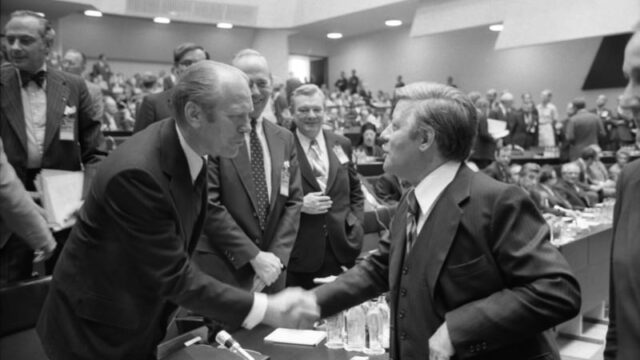
What Are the Helsinki Accords?
On August 1, 1975, the Helsinki Accords, also known as the Helsinki Final Act, were signed. The signing of the Helsinki Accords was a big moment for the international community, bringing security and human rights to the forefront of diplomacy.
These Accords were signed during a tense period in world history: the Cold War. Despite ongoing tensions, countries from both sides of the war came together at the first Conference on Security and Cooperation in Europe (CSCE) in 1973. At the 1975 CSCE, thirty-five countries signed the Helsinki Accords, including the United States, the Soviet Union, and several European countries.
Because of the Cold War, tensions were high, and countries wanted to find ways to come together, also known as a multilateral approach, on human rights and security. Because of the Helsinki Accords, human rights became an ongoing priority within international security dialogues between the United States, the Soviet Union, Canada, and Europe.
The Cold War was a time of great uncertainty with the Soviet Union and communism both rising in power. During this period, many countries prioritized their own security and European security. European countries were wary of engaging in dialogue with the Soviet Union, out of fear that it would lead to increased communist influence in the region. However, this slowly shifted in the 1970s as countries became more open to negotiating at formal meetings. One such meeting was the 1972 Helsinki Consultations.
Although they were now engaging in discussion, countries were not very successful in making official progress until the first CSCE in 1973. Here, countries created an agreement on security and human rights, which became the 1975 Helsinki Accords.
Historical Context of the Helsinki Accords
The Helsinki Accords were produced under a tense geopolitical environment. But, the CSCE was able to offer a venue for negotiation and discussion. The CSCE began on July 3rd, 1973, in Helsinki, Finland.
The Conference began because the Soviet Union wanted to discuss European security topics. The Soviet Union initially proposed this conference in 1954 at the Geneva Conference with the goal of formalizing Eastern Europe’s political boundaries from World War II. However, in the 1950s and 1960s, countries such as the United States were hesitant because of the potential consequent solidification of Soviet boundaries, with its annexation of Estonia, Latvia, and Lithuania, and communism.
Despite concerns about the Soviet Union’s growing power, in 1972, the United States, the Soviet Union, Canada, and many European countries were able to come together with the Helsinki Consultations. These Consultations were formalized in 1973 with the first official CSCE. Given the high level of tension and significance of these countries coming together, the Helsinki Accords represent an impressive moment of countries prioritizing international cooperation.
What Was in the Helsinki Accords?
The Helsinki Accords focused on three major issue areas, also known as “baskets,” with a fourth focused on scheduling follow-up meetings. The three baskets focused on security, economics, and human rights respectively.
Basket 1 is focused on security through ten principles, including sovereign equality, territorial integrity, and respect for human rights. This basket highlighted the intersection between security and human rights.
Basket 2 focused on the rising role of “economic, scientific, and environmental cooperation.” This basket covered the importance of free market economies and discussed environmental security threats.
Basket 3 focused on the human dimension with humanitarian cooperation and creating guidelines for human rights.
Finally, Basket 4 described the importance for these countries to develop a schedule to meet and maintain the Conference’s proceedings.
Who Created the Helsinki Accords: Diplomacy in Action
The United States was a key negotiator of the Helsinki Accords. The looming threat of a strengthened Soviet position in Europe and communism, along with the status of human rights and security, motivated the United States’ involvement. President Gerald Ford and Ambassador George S. Vest were key leaders in creating the Accords.
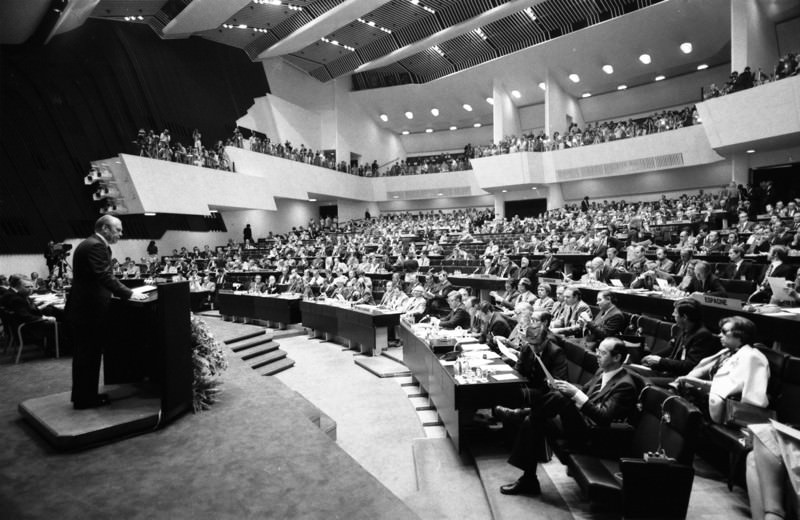
What Was President Ford’s Role?
President Ford understood the need for greater cooperation on security and human rights issues in Europe. This prompted his attendance at the CSCE in 1975. Before he left, President Ford addressed Eastern European Americans on July 25th, 1975, and stated,
“The Helsinki documents involve political and moral commitments aimed at lessening tensions and opening further the lines of communication between the peoples of East and West. It is the policy of the United States, and it has been my policy ever since I entered public life, to support the aspirations for freedom and national independence of the peoples of Eastern Europe and—with whom we have close ties of culture and blood—by every proper and peaceful means.”
President Ford, July 25, 1975
President Ford wanted to make his CSCE intentions clear to the public. Not everyone supported President Ford’s engagement. Some members of the American public felt that the United States’ involvement would solidify political division in Europe and Soviet influence, as well as degrade the political and military strength of the North Atlantic Treaty Organization.
President Ford’s speech addressed the concerns of the public. By making this statement, President Ford brought American pillars of diplomacy—security, prosperity, democracy, and development—to the forefront of foreign policy decision-making.
Negotiation was critical in the development of the Helsinki Accords. Both the United States and Europe, and the Soviet Union had to make some concessions. Some viewed the Accords as supporting Soviet influence with its annexation of Estonia, Latvia, and Lithuania. But, the Accords also urged the Soviet Union to abide by human rights norms and regulations.
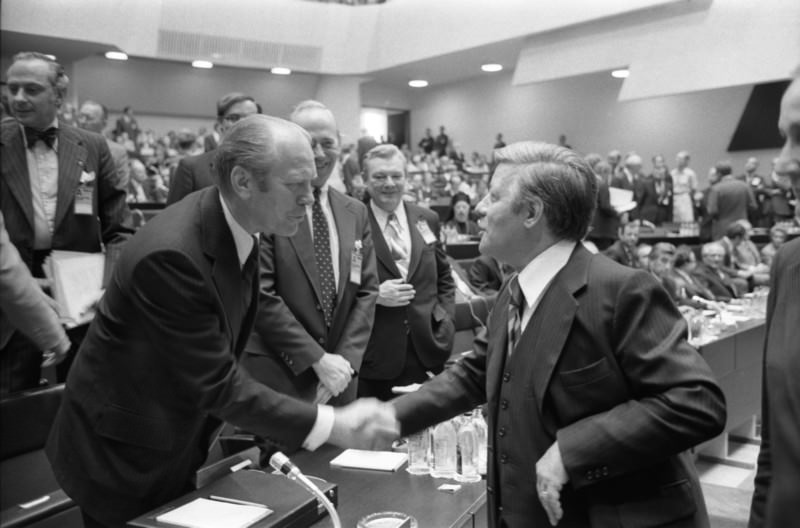
George Vest: The U.S. Diplomat Behind the Helsinki Accords
While President Ford played an important role in the development of the Helsinki Accords, many American diplomats also worked behind the scenes to make them possible. George S. Vest was one such negotiator and spokesperson for the Helsinki Accords.
George S. Vest was an American diplomat, who in 1989 gained rank as a career ambassador. Vest dedicated his life to public service—serving as a combat veteran in World War II and joining the Foreign Service in 1947.
Vest had numerous diplomatic assignments ranging from Latin America to France and assignments with the North Atlantic Treaty Organization. Vest became very involved with European affairs, and in 1973, he was selected to serve as a lead negotiator at the CSCE. Even after his term, Vest continued to grow in his positions as a spokesperson and later political and military affairs advisor for Secretary of State Henry Kissinger, nominated ambassador to Pakistan, Assistant Secretary of State for European Affairs, and U.S. ambassador to the European Union.
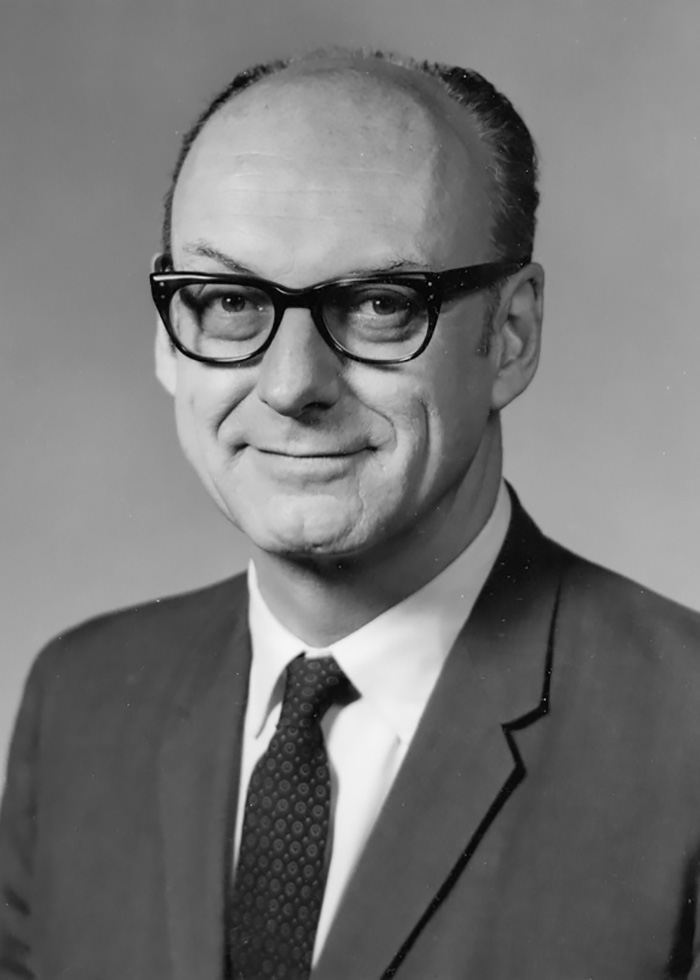
George S. Vest was very involved in preparing for the Helsinki Accords. Particularly, he led discussions on human rights and cooperation leading up to the CSCE. Ambassador Vest was also responsible for naming the four issue-area “baskets” in the Helsinki Accords. This contribution left his mark on the structure of the Accords. It also demonstrated the United States’ pivotal role in leading multilateral negotiations.
In an interview with the Washington Post, George S. Vest described his work with the CSCE. He stated how he, “especially loved the Helsinki experience because a lot of people making policy here in Washington didn’t have much interest in it and gave me extraordinary leeway to run my own show.”
Ambassador Vest helped mold the United States’ involvement in the CSCE. Part of the challenge of being a diplomat is having to respond to situations rapidly while being innovative and composed. During the CSCE preparatory talks, Vest had minimal instructions from the United States. So, he was responsible for navigating countries’ diverse interests and objectives.
Ambassador Vest faced this obstacle when deciding where to hold the CSCE conference. Ultimately, the first 1973 CSCE, as well as the 1975 signing of the Helsinki Accords, were held in Helsinki, Finland. However, the discussions in their interim took place in Geneva, Switzerland.
To reach this agreement, Vest had to undergo a serious negotiation process. The Soviet Union wanted the Conference in Geneva. But, the Scandinavian representatives pushed for Helsinki. Though it may seem like a trivial matter, Vest recognized the symbolic nature of the debate. Considering both sides, Ambassador Vest decided to support the Scandinavian countries.
Waiting on word from Washington, Vest had to take matters into his own hands. Ambassador Vest approached the situation with awareness, composure, and leadership. Using these skills, he began motivating countries to side with Helsinki over Geneva.
In his telling during an oral history, Vest described that when he did receive word from Washington, he learned he was supposed to “support Geneva. Obviously Kissinger had been gotten to and they let it go through.” The Conference commenced and the Accords were signed in Helsinki, just as Vest argued for.
How Were the Helsinki Accords Used? What Difference Did They Make?
The Helsinki Accords also contributed to the conclusion of the Cold War. Because of the Helsinki Accords, human rights became a central priority for the thirty-five countries that signed the Accords.
Considering this priority, human rights advocates developed the Helsinki Monitoring Groups. The Helsinki Monitoring Groups tracked and raised awareness of human rights violations and atrocities. The Helsinki Accords also scheduled review meetings to check compliance with ‘baskets.’ Specifically, at the Belgrade review meeting, the work of the Helsinki Monitoring Groups became formalized with monitoring and drawing attention to violations.
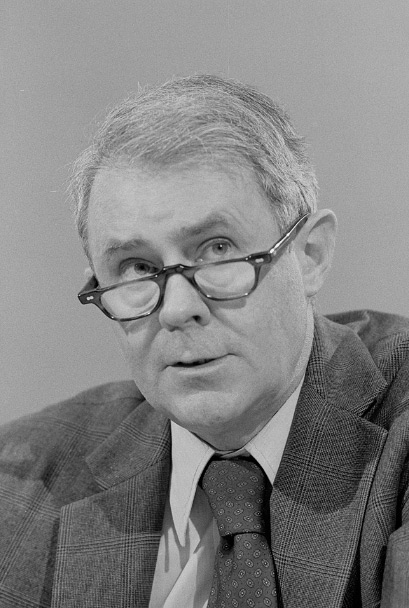
Because of Ambassador Vest’s work and the Helsinki Accords’ requirements, Secretary of State Cyrus V. Vance was able to draw attention to Soviet human rights violations including the arrests of dissidents, poor working conditions for Western journalists, families separated across borders, and lack of freedom of thought. On June 6, 1977, in a Congressional-Executive testimony, Secretary Vance stated, “We seek full implementation of all the commitments contained in the Helsinki Final Act… The freer flow of people and ideas is as important to long‐term security and cooperation as, for example, advance notice of major military maneuvers; the humanitarian pledges at Helsinki are as important as, say, the promises of greater commercial cooperation.”
Secretary Vance described the United States’ commitment to the Accords and how “the United States will not back down with respect to its position on human rights.”
The Helsinki Accords highlighted the intersection of security and human rights, which carried on a legacy through their implementation in other human rights and humanitarian agreements. For example, the 1989 Vienna Concluding Document referred to these objectives as the Human Dimension. These agreements were also fundamental to the development of new CSCE Conferences. These new CSCE Conferences contributed to political and social change in Europe, decreased Soviet influence, and ultimately supported the conclusion of the Cold War.
The Helsinki Accords also led to greater cooperation with countries coming together within the Non-Aligned Movement, the North Atlantic Treaty Organization, and the Warsaw Pact.
Do the Helsinki Accords Still Matter?
The Helsinki Accords were a turning point in security and human rights cooperation. But, what do they mean for the world today? In the aforesaid 1989 interview, Ambassador Vest described that,
“More than a decade later, we’re seeing an almost daily demonstration of how the Helsinki agreements are opening a whole new chapter in East-West relations—something that we frankly couldn’t foresee at the time—and I can’t help taking pride in the part I played back then.”
Ambassador George Vest
With the Helsinki Accords now approaching 50 years, the intersection of human rights and security is just as important to consider. The work of President Ford and Ambassador Vest still lives on and cannot be forgotten. Not only did these individuals define the importance and intersection of international security and human rights, they also laid the groundwork for multilateral negotiation and global cooperation, which will carry on for years to come.
References:
“Building a Career on The Unexpected,” John M. Goshko, Washington Post
Cold War Diplomacy, National Museum of American Diplomacy
Helsinki Accord and the Soviet Union: Effects on Human Rights Seem Mixed, The New York Times
Helsinki Accords, Gerald R. Ford Presidential Library & Museum
Helsinki Final Act, 1975, Department of State Office of The Historian
History, U.S. Mission to the OSCE
North Atlantic Treaty Organization
Oral History of George S. Vest, Association for Diplomatic Studies and Training
The Human Dimension, Commission on Security and Cooperation Europe
The Helsinki Final Act, Commission on Security and Cooperation Europe
The Helsinki Process and The OSCE, Commission on Security and Cooperation Europe
The Skills of Diplomacy, National Museum of American Diplomacy
U.S. to Press Soviet on Helsinki Accords, Bernard Gwertzman, The New York Times
What are The Key Pillars of American Diplomacy, National Museum of American Diplomacy
What was The Warsaw Pact?, North Atlantic Treaty Organization
Special thanks to our intern Anmol Chowdhary for writing this article.